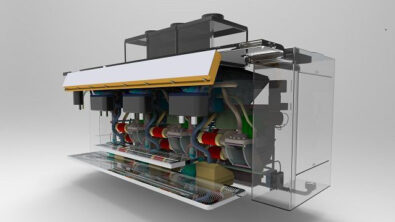Potential of constant optimization in the Consumer Product Industry with Digital Twins

The customer now controls the value chain, and retailers are shifting their customer experience strategies toward real-time contextual personalization based on dynamic customer journeys and segment-of-one consumer profiling. Consumer demand for personalized experiences and products, ever-increasing time-to-market requirements (from months to days), increasing product complexity, demand for “size-of-one” lots in manufacturing processes, and the emergence of technologies such as artificial intelligence (AI), the Internet of Things (IoT), and blockchain are all driving dramatic changes in the consumer industry. As a result of such a significant shift, retailers are investing heavily to digitally transform their businesses.
For CP companies to enable new customer experience-led business models, they must embrace digital platforms and become data-driven. The automated collection and analysis of customer, product, and process data — unified to enable platform-based collaboration across the ecosystem of partners and suppliers — enables CP companies to continuously innovate their offerings at speed and scale.
By leveraging digitalization platforms that provide the environment for digital twins of products, assets, and ecosystems, CP companies can plan, manage, and execute this complex set of activities. The CP industry is very interested in digital twins because they promise to improve innovation and design, visually enhance collaboration, and enable the ongoing operation of connected products and assets — all in a fast-paced, digitally transforming, competitive environment for manufacturers.
Digital twins, or virtual representations, can be used to manage multiple aspects of a CP business, including product and package design, ongoing optimization of connected products, and manufacturing process modeling, operation, and optimization.
The Benefits of Digitalization Platforms for Consumer Products Manufacturers
CPs can use digital twins to leverage a visual vehicle that transfers information and knowledge across digital platforms. Digital twins can cover a wide range of information, such as new product ideas, manufacturing or service work instructions, sections of a design, or the full fidelity product or asset model. As the value of having a full-fidelity twin and networks of related twins becomes clear, CP companies are actively investing their resources in adopting digital twins. The key overall value of digital twins is that they can serve as repositories for multiple data models related to a product or asset along a single digital thread: production, supply chain, service delivery, or customer.
Digital twins have several advantages, including:
Improved speed and agility
With the help of a digital twin, CP companies can test and validate a product before it even exists in the real world. By creating a digital replica of the planned production process, CP companies can identify any process failures before the product enters production. Engineers can disrupt the system to create unexpected scenarios, then analyze the system’s response and identify mitigation strategies. This new capability improves risk assessment, accelerates the development of new products, and increases the production line’s reliability.
Support direct-to-consumer (D2C) business models and shifting consumer trends
The growing importance of consumer digital commerce activities in total revenue is accounted for by a CP’s digital strategy that prioritizes consumer-driven value generation. Historically, D2C business models were viewed as difficult to build and maintain frameworks. Furthermore, there are preconceived notions about the likelihood of potential conflicts with the distribution industry. D2C business models are now critical assets for CP organization growth. Businesses can differentiate their offerings based on the individual downstream stages of the value chain, giving them greater control over the customer experience. In this context, digital twins provide the foundation for CP organizations to adapt their products and offerings based on an analysis of direct consumer interactions. The most important overall benefit of digital twins is that they can serve as repositories for multiple data models related to a product or asset along a single digital thread: production, supply chain, service delivery, or customer.
Enable personalization and mass customization
Closely related to D2C business models, CP companies must design and realize size-of-one lots to serve “segments of one.” According to IDC, 50 percent of manufacturers will have integrated simulation and configuration tools with customer profile data by 2024, resulting in up to 2% revenue gains. Digitalization platforms are the assets that translate individual customer requirements into product specifications.
Deliver innovation at speed and scale
Overall, digitalization platforms provide more opportunities for CP companies to execute innovation strategies that go beyond pure technology and product innovation. Platforms that allow them to manage and streamline the various and complex stages of product realization, leverage collaboration across the extended value chain, and capitalize on customer experience are critical for piloting innovative business models. After identifying successful pilots, digitalization platforms enable CP companies to scale innovation across complex geographical, organizational, and technological structures. This, in turn, ensures distributed visibility and access to digital twins while also ensuring central control of business model execution.
Siemens Xcelerator delivers digitalization solutions to help consumer goods companies of all sizes become digital enterprises
Digital twin technologies are now available and can bring the benefits listed above to your Consumer products company in the short and long term by bridging communication between product development, manufacturing, and supply chains to benefit from speed, product personalization, and improved customer experiences. To stay competitive, now is the time to begin analyzing and implementing this new and disruptive technology.
Siemens offers Xcelerator, a comprehensive, integrated portfolio of software, services, and an application development platform, to assist CP companies in doing so. It is designed to help companies of all sizes become digital enterprises with solutions that can be tailored and adapted to fit customer and industry-specific needs.
Want to learn how to get started?


